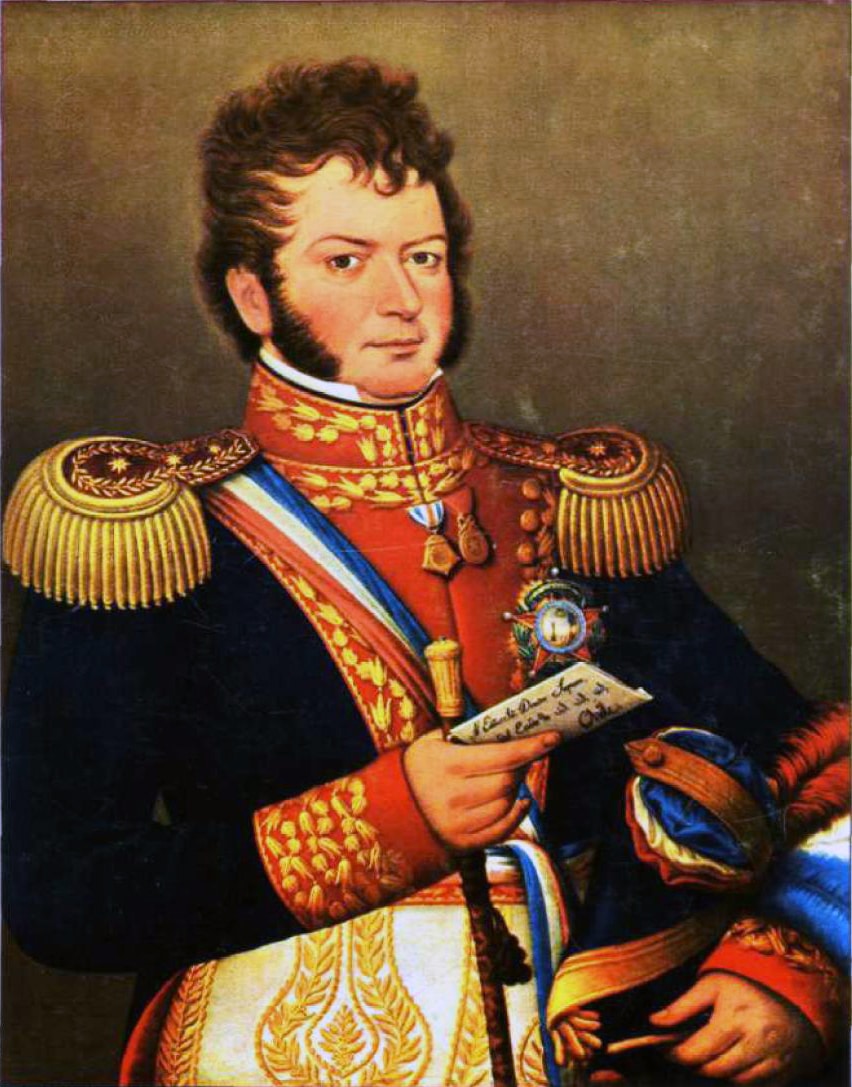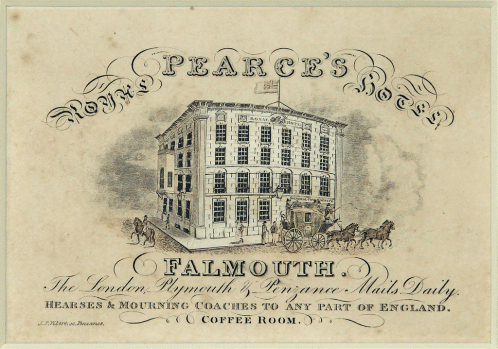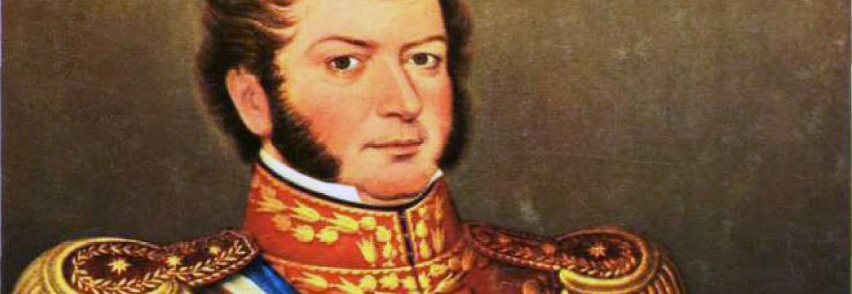By Linda Batchelor.
In 1799 Bernardo Riquelme, a young man in his early twenties, born in Chile and educated in England since 1794, was in Falmouth awaiting a voyage to Lisbon. The voyage to Lisbon was the first step in his ultimate return to Chile but with little money and uncertainty as to his future he left England in late April or early May.
Some years later in Chile as Bernardo O’Higgins he became known as the Liberator and revered for transforming Chile into a republic free from the rule of Spain. This article was prompted by a research enquiry to the Bartlett Library concerning this early part of Bernardo’s history, his journey to Falmouth from London and his voyage from Falmouth to Lisbon.
Bernardo O’Higgins
Bernardo was born in Chillan in southern Chile in 1778, the illegitimate or natural son of Ambrosio O’Higgins, a rising figure in the Spanish colonial administration, and Isabel Riquelme the daughter of a prominent local family. The liaison between Ambrosio and Isabel, who at eighteen was almost forty years his junior, resulted in a son but never led to marriage and Bernardo spent his early years with his mother’s family. He was known as Bernardo Riquelme and was never openly acknowledged by his father but Ambrosio supported him financially and arranged for his education in South America and Europe and on his deathbed bequeathed considerable estates in Chile to his son who then finally took his father’s name.
Bernardo’s father, Ambrosio, had been born Ambrose Higgins to a catholic family in County Sligo, Ireland in 1720. In 1751 he left for Spain, which was a magnet for ambitious young Irishmen, and settled in Cadiz. There he joined an Irish merchant firm the Butler Trading House and began to make his way in business and in Spanish society. Five years later he sailed for the Spanish American colonies to sell goods on behalf of Cadiz businessmen. He spent time trading in various of the colonies and settlements before being hired for the Spanish Imperial Service in Chile by the Irish born Captain John Garland of the Spanish Engineering Corps. In 1764 Ambrose was commissioned into the Spanish army and by then had adopted the Spanish version of his name as Ambroisio O’Higgins. He rose rapidly through the ranks to Field Marshal and then Captain General of Chile before becoming Viceroy of Peru (including Chile) in 1796. Loyal to Spain and the Spanish Imperial Service and devoted to the development of the Spanish American colonies he was rewarded with the title of Marquis de Osorno by the Spanish King.

Portrait of Bernardo O’Higgins holding the Chilean Constitution by Jose Gil de Castro. Instituto Geografico Militar de Chile.
Bernardo In England
Bernardo lived in Chile with his mother’s family or with close friends of his father until he was fifteen when Ambrosio arranged for him to be educated in Lima in Peru. From there he was sent to Europe, financially supported by Ambrosio, and arrived first in Cadiz were he was put in the charge of Chilean born Nicolas de la Cruz. Nicolas, a close friend and associate of Ambrosio, was a prominent man in Cadiz where he had lived since a young man. He was a successful merchant, writer and commentator and he was able to give the young Bernardo an introduction into Spanish society.
After a year in Spain, still under the name of Riquelme, Bernardo moved to London where he was to be supported by Ambrosio’s business associates, the watchmakers Spencer and Perkins of Snow Hill, London. It is not entirely clear what part they were to play in Bernardo’s education but they were provided with an annual sum of money from Ambrosio to support him. Bernardo remained in London from 1795 until 1799 and for some of those years he was educated at the Catholic School in Richmond, Surrey run by Mr Timothy Eeles. The Roman Catholic Relief Act 1791 had allowed for the provision of Catholic places of worship and schools. Soon after a Catholic Mission and Chapel was established in the Vineyard in Richmond and Mr Eeles school was set up nearby at Clarence House. An advertisement for the school in Laity’s Directory of 1794 stated, ‘Young gentlemen taught Latin, Greek, English and French languages: also writing, arithmetic, book-keeping, geography, history, the use of globes and every other branch of mathematics; for which, with boarding washing and lodging on other charge will be made than 30 guineas per annum.’
Whilst at the school and during his time in London, Bernardo became acquainted with the liberal thinking of the time and ideas of political independence. He also encountered a number of political activists especially those involved in the nationalist politics of the Spanish American territories. One of these was the Venezuelan born Francisco de Miranda who had arrived in Spain from Venezuela in 1771. He had served as an officer in the Spanish military but subsequently left Spain and spent time in France, the United States, Russia, Sweden and England. He became involved with revolutionary ideas and dedicated to the movement for the independence of the Spanish American territories from colonial rule by Spain. During his time in London Miranda may have taught mathematics at Mr Eeles school and this may have been have been the way in which he met the young Chilean. He was to have a lasting influence on Bernardo who also joined the secret masonic lodge established in London by Miranda dedicated to South American independence.
By 1798 Bernardo was in financial difficulty and the funds provided by Ambrosio for his support through Spencer and Perkins were no longer forthcoming. He described his fear of never being able to return home in a letter to his father and his situation as ‘my misfortunes.’ Whether this was because of Bernardo’s extravagance, failure by Spencer and Perkins or Ambrosio’s knowledge of Barnardo’s political affiliations is unclear. Barnardo appealed for help from Nicolas de la Cruz to leave England and return to Chile. Eventually in 1799 de la Cruz provided him with some funds, initially to return to Cadiz via Lisbon. Bernardo may have also been assisted in some way by Miranda and on 25th April he was granted a passport in London by the Duke of Cumberland and left for Falmouth to sail for Lisbon probably in early May.
Reaching Falmouth
It is not known how Bernardo travelled approximately 267 miles between London and Falmouth but this presumably would have occurred after the passport was granted on 25th April and there would have been various options open to him.
He may have travelled by sea as this would have been a cheap option but it would usually take up to a week or longer depending on the carrier and it is more likely that he would have reached Falmouth by road. He may have hired a private carriage or chaise but if Bernardo had limited funds this was an extremely expensive means of travel. The cost of such a private hire was £46 19s Id when Lieutenant Laponotaire rushed the news of Trafalgar and the death of Nelson to the Admiralty from Falmouth in 1805. If there was no urgency the journey could usually take about five days with overnight stops adding to the cost.
Another option could have been by Stage or Mail Coach. The journey by Stage Coach would be public travel by stages from London via Exeter into Cornwall and then on to Falmouth. The cost was 2d or 3d per mile if travelling inside the coach but half that amount per mile if travelling outside. The journey would take on average two to three days depending on weather conditions, breakdowns and other travel hazards. The Mail Coach was also public travel but the main purpose was to carry the mails for the Post Office and therefore they carried only four passengers inside with more outside They were generally faster, more comfortable, less likely to suffer breakdowns or faults and potentially safer as they were accompanied by an armed guard. Mail Coaches started their journeys from London nightly from Piccadilly. At the time of Bernardo’s journey he would have only been able to travel as far as Exeter on a Mail Coach, approx 157 miles from London, as the route was not extended to Falmouth until 5th July 1799. He would have to take the Stage coach for the last part of the journey but he could probably have reached Falmouth in about 2 days. The cost of travel by Mail was 1d extra per mile over the Stage Coach fare.
Sailing to Lisbon
Bernardo may have taken a berth on a number of vessels trading between Falmouth and Portugal or Spain but the usual route for passengers to Lisbon from Falmouth would be by packet ship and is the most likely passage for Bernardo. The Post Office Packet Service was a branch of the Royal Mail established to carry international mails and government dispatches and Falmouth with its deep estuary, good anchorage and location became an important packet station in 1688. The Lisbon route was one of the earliest and one of the most important. By the time of Barnardo’s journey there were usually four packet ships serving Lisbon under the command of the most senior captains in the service. The mails for Lisbon were made up in London on Wednesdays and the packet ship sailed by Fridays or Saturdays conditions permitting. The passage usually took between eight to fifteen days depending on weather, clashes with enemy or privateer vessels and other emergencies of the voyage.
Although the mails were the priority, packet ships also carried passengers, bullion and freight. Passengers stayed in Falmouth at hotels such as Wynn’s Hotel (later Pearce’s Royal Hotel) or in one of the many lodging houses awaiting sailing.

Pearce’s Royal Hotel was a coaching inn and stables in Falmouth in the Packet Service era. Falmouth Art Gallery
The cost of a passage in a packet ship to Lisbon about this time was £22 1s for cabin passengers or £13 13s for steerage. Cabin passengers were accommodated in six timbered cabins each about six foot long and four foot wide containing one or two single bunks. A replica of one of these passenger cabins is on display in the Maritime Museum’s Packet Gallery. Steerage passengers berthed in cots or hammocks in the common mess-room. On the Lisbon route passengers provisions were found by the commanders. With limited funds Barnardo would most probably have travelled steerage if he took passage on a packet ship.
In 1799 the four Packets on the regular Lisbon run were HMPs Walsingham, King George, Prince of Wales and Prince Adolphus. After Barnardo had obtained his passport in London on 25th April and had made his way to Falmouth the most likely dates for his sailings to Lisbon are listed as in May and early June. On 6th May Walsingham sailed under the command of Captain Couse. On 24th May King George sailed commanded by her Master, Mr Betts and on 8th June Prince Adolphus sailed under the command of Captain Boulderson.
Bernardo would have reached Lisbon from Falmouth but this was not the end of his journey of return to Chile. He would still have to complete his journey to Cadiz by some means and his arrival there was not well received. As Ambrosio had withdrawn his support for his son, Bernardo suffered a number of difficulties and privations during his remaining time in Europe. Before Bernardo was able to return to Chile, Ambrosio died in Lima, Peru in 1801 but he left his considerable estates in Chile to Bernardo, who eventually returned there in 1802 to claim his inheritance. He took up his role as a prominent and wealthy landowner and remained living quietly on his estates until 1810 when he joined the revolution against Spanish rule. He was prominent in the revolutionary wars which resulted in Chile becoming an independent republic and from 1817 to 1823 he became Supreme Director of Chile. He was forced from office in 1823 by rival factions and went into exile in Peru where he remained for the rest of his life. In 1842 the National Congress in Chile invited him to return to his homeland but he died that year in Lima before he could do so. The Bernardo Riquelme who left Falmouth in 1799 today as Bernardo O’Higgins is acknowledged and honoured as one of the founding fathers of Chile.
The Bartlett Blog
The Bartlett Blog is written and produced by the volunteers who staff The Bartlett Maritime Research Centre and Library of National Maritime Museum Cornwall. Bernardo O’Higgins was written by Linda Batchelor.
The Bartlett Library holds a Collection of over 20,000 volumes and offers access to one of the finest collections of maritime reference books, periodicals and archival material. The Bartlett Blog reflects the diversity of material available in The Bartlett Library.



